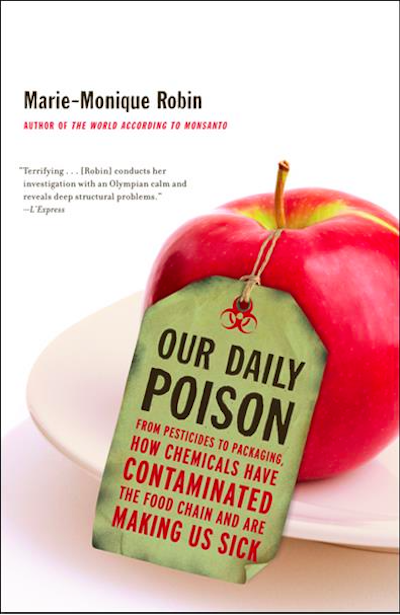Our Daily Poison: How Chemicals Have Contaminated the Food Chain and Are Making Us Sick
Marie-Monique Robin

In a 1996 report entitled Pesticides and the Immune System: The Public Health Risks, which was commissioned by the prestigious World Resources Institute (WRI) in Washington, DC, Robert Repetto and Sanjay Baliga write: “The scientific evidence suggesting that many pesticides damage the immune system is impressive. Animal studies have found that pesticides alter the immune system’s normal structure, disturb immune responses, and reduce animals’ resistance to antigens and infectious agents. There is convincing direct and indirect evidence that these findings carry over to human populations exposed to pesticides.”
“That document sparked the chemical industry’s wrath,” explained Robert Repetto, an economist who specializes in sustainable development and who was vice president of the WRI when the report was written. “It was the first time a study had gathered all the available data on the effects of pesticides on the immune system, a subject that was completely underestimated at the time and, in my opinion, continues to be now, even though it is crucial to understanding the epidemic of cancer and autoimmune diseases that are observed, notably in industrialized countries.”
Indeed it is — and we will revisit this — as cancer is rarely caused by one factor alone; more often it is the result of a complex and multifactorial process, generally initiated by the action of pathogens (or of antigens), such as rays, viruses, bacteria, toxins, or chemical pollutants, and possibly favored by genetic predispositions, lifestyle, or diet. In good health, the body can defend itself against the aggression of pathogens by mobilizing its immune system, whose function is precisely to track and eliminate intruders using the action of three distinct, but complementary, mechanisms.
The first, which biologists call “nonspecific immunity,” involves macrophages and neutrophils that consume invaders (the process is called “phagocytosis”), and natural killer (NK) lymphocytes, whose mission is to exterminate them. The second, named “humoral immunity,” activates B lymphocytes, producing antibodies. Finally, the third, “cellular immunity,” sets T lymphocytes (T4 or T8) in motion, which poison the intruders that were phagocytized by the macrophages thanks to the secretion of lymphotoxins.
In their lengthy report, Robert Repetto and Sanjay Baliga devote 15 pages or so to the numerous in vivo (that is, directly on animals) or in vitro (on cell cultures) studies that have shown that pesticides can disturb one or more of the mechanisms that make up the immune system. From this long list, of which organochlorines (DDT, lindane, endosulfan, dieldrin, and chlordecone) make up the lion’s share, I chose the example of atrazine, an herbicide that was banned in Europe in 2004 but continues to be used in massive quantities, notably in the United States. When administered orally to mice, atrazine disturbs the action of T lymphocytes as well as the process of phagocytosis by macrophages. In another study published in 1983, researchers demonstrated an effect on the weight of the thymus in exposed rats. (The thymus is an essential organ in the immune system, as it is where T lymphocyte maturation takes place, and it also plays a role in the protection against autoimmunity — that is, the fabrication of antibodies, which, instead of attacking intruders, target immune system cells.) Finally, another experiment in 1975 revealed that salmon exposed to atrazine through oral or cutaneous methods showed a lower weight of the spleen, an organ involved in controlling bacterial infections, such as pneumococcal or meningococcal ones.
However, as Repetto and Baliga point out, the immune system anomalies observed in lab animals following exposure to pesticides have also been observed in wild fauna. For example, in Canada, autopsies of whales found dead on the shores of the St. Lawrence Estuary showed an elevated concentration of organochlorine pesticides and PCBs, as well as an abnormal rate of bacterial infections and cancer. Sylvain de Guise, who conducted a study on the abnormally high death rate of the cetaceans, explains that only “two factors could have contributed to such a high prevalence of neoplasms in that single population: exposure to carcinogenic compounds and decreased resistance to the development of tumors.”
Similarly, in the early 1990s, a strange epidemic decimated the dolphins of the Mediterranean; dozens of their corpses turned up on the coast of Valencia, in Spain. Autopsies revealed that the marine mammals had succumbed to an infection brought on by viruses they could normally overcome (such as morbillivirus). “We have gone back over the literature for more than a hundred years and we have found nothing like it, no other cluster of virulent epidemics like we have now,” a British researcher commented. In the end, studies concluded that the mass deaths had to be due to lowered immune defenses in the dolphins, whose bodies had accumulated organochlorine pesticides, PCBs, and various chemical pollutants in their bodies.
The studies conducted on fauna showing the immunosuppressive effects of pesticides are numerous, but one of them is particularly impressive. It all started during the 1980s, when zoologists noticed that seals living close to ports in the Baltic and North Seas were succumbing in huge numbers to morbillivirus infections. Dutch researchers decided to conduct a prospective experiment. They captured baby seals off the northwest coast of Scotland, considered relatively unpolluted. The friendly mammals were divided into two groups: the first was fed with herring from the Baltic Sea, where the pollution rate is significant; the second was fed with herring caught in Iceland, where contamination is very low. It is worth noting that the herring for both groups was bought at “normal” markets — that is, destined for human consumption. After two years, the fat of the seals in the first group showed a concentration rate of organochlorine pesticides ten times higher than that of the control group. The researchers also observed that the seals fed with contaminated herring had immune defenses three times weaker than those of the control group, notably with a very clear reduction in NK cells and T lymphocytes, and lower neutrophil levels and antibody responses.
At a conference held in February 1995 in Racine, Wisconsin, where he presented his team’s work, Dutch virologist Albert Osterhaus noted that this was “the first demonstration of immunosuppression in mammals as a result of exposure to environmental contaminants at ambient levels found in the environment.” Incidentally, it’s worth noting the title of the conference: “Chemically-induced Alterations in the Developing Immune System: The Wildlife/Human Connection.”
Allergies and Autoimmune Diseases: Effects on Humans
As Robert Repetto and Sanjay Baliga point out, “the immune systems of all mammals (but also of birds and fish) have similar structures,” and what happens to whales, dolphins, or seals concerns us directly. They cite as evidence studies carried out on cyclosporine, an immunosuppressant medication prescribed to organ transplant recipients to stop the body from rejecting the transplant. Researchers observed that the drug “has been found to have similar toxicological and immunosuppressive properties in a wide variety of mammalian species, including rats, mice, monkeys and humans,” which, in the long run, lay the grounds for cancer. Indeed, as shown by Arthur Holleb, an oncologist and former chief medical officer of the American Cancer Society, patients treated with cyclosporine are one hundred times more likely to develop lymphatic cancer, in particular leukemia and lymphoma. Need we recall that these are precisely the malignant tumors for which farmers show a heightened risk?
In their report, Repetto and Baliga present several studies carried out by Soviet scientists, who scrupulously took a census of the effects of pesticides on the immune system. “It was very valuable, because at the time, Western studies were only interested in cancer and neurodegenerative diseases,” Repetto explained during our phone interview. “Also, the communist bureaucracy was an advantage: as there was no profit mentality — which is different from capitalist countries, where manufacturers are interested in hiding the toxicity of their products, out of fear of seeing their sales drop — the Soviet researchers carried out what was essentially true health monitoring, by conscientiously recording all the effects observed in farming populations, with the goal of lowering the health care costs they might generate.”
At the risk of seeming like an inveterate crypto-communist, I must admit that listening to these words, I thought that there was some merit to the “bureaucratic” scientific research — meaning independent from private interests — and that this outdated model should inspire regulatory agencies that generally forget to include potential medium- or long-term health care costs in their evaluation of chemical products. People will retort that the studies by “bureaucratic” researchers have not prevented catastrophic pollution of vast areas of the former Soviet Union (such as the Aral Sea), which is true. Nevertheless, as we will see later on, the explosion of chronic illnesses is tugging strongly at the purse strings of social security systems, which fall prey to a regulatory system where agro-economic considerations (the famous “benefits” pesticides supposedly offer) take precedence over health considerations (the “risks” associated with said “benefits”).
[If you like what you are reading, help us spread the word. “Like” Rural America In These Times on Facebook. Click on the “Like Page” button below the wolf on the upper right of your screen.]
In the meantime, the “bureaucratic” scientific literature has nonetheless shown that exposure to pesticides causes autoimmune reactions; it also leads to a disturbance in neutrophil and T lymphocyte activity, which contributes to the development of pulmonary and respiratory infections. Several studies conducted between 1984 and 1995 in the cotton-producing regions of Uzbekistan, where large quantities of organochlorine and organophosphorus insecticides were sprayed, showed extremely elevated rates of respiratory, gastrointestinal, and kidney infections not just in farm laborers, but also in the populations living close to the treated zones. At the same time, in the West, researchers were showing that exposure to pesticides such as atrazine, parathion, maneb, and dichlorvos triggered allergies, leading to what Dr. Jean-Luc Dupupet calls “cutaneous manifestations”, or in other words, types of dermatitis that are the expression of an immune system reaction to a chemical aggression.
In its manual for pesticide poisoning prevention published in 2006, the WHO devotes a significant portion to autoimmune diseases and allergies, the prevalence of which keeps rising, especially in children. The manual notes: “Allergies can have many manifestations, including hay fever, asthma, rheumatoid arthritis and contact dermatitis. The cause of allergies is a hypersensitivity response which occurs after exposure to some occupational and environmental agents. Antigens that cause allergic responses are called ‘allergens.’ [ … ] When the immune system loses the ability to distinguish between the body’s own cells and foreign cells, it attacks and kills host cells, resulting in serious tissue damage. This condition is called ‘autoimmunity’. Although it is not as common as immunosuppression or allergy, occupational exposure to certain chemicals has been associated with autoimmune responses.”
During our phone interview, Robert Repetto said that the report he wrote for the WRI triggered a lively (allergic!) reaction from manufacturers, whose scientists, just this once, decided to collectively author a “critique” in the journal Environmental Health Perspectives. The selection’s signatories included licensed epidemiologists from Dow Chemical (Carol Burns and Michael Holsapple), Zeneca (Ian Kimber), DuPont de Nemours (Gregory Ladics and Scott Loveless), BASF (Abraham Tobia) and, of course, Monsanto, meaning Dennis Flaherty and John Acquavella, the author of the controversial meta-analysis. After offering a firm criticism of the report, notably of the Soviet studies that they deemed “difficult to evaluate,” the authors end their article with remarks that are contradictory, to say the least. It is unclear whether they express embarrassment or a well-calculated conciliatory strategy. They write that they “do not find consistent, credible evidence” that there is a widespread phenomenon of immunosuppression linked to pesticide exposure. Nonetheless, the WRI report is an important document because it focuses attention on a potentially important issue for future research and brings a substantial literature of foreign language studies to the attention of Western scientists.
Here we have a perfect example of “the art of blowing hot and cold.” But, as we will see, when it comes to neutralizing the impact of studies not in their favor, manufacturers’ attitudes can be much more drastic, even perverse. But before examining how the regulation of chemical products that come into contact with the food chain functions, it is important to go back to the industrial history of the 20th century, in order to understand how extremely toxic compounds managed to poison the environment and human populations, not just in the short term, but for many years to come.

This excerpt originally appeared in Our Daily Poison: From Pesticides to Packaging, How Chemicals Have Contaminated the Food Chain and Are Making Us Sick published by The New Press. Copyright © 2014.





